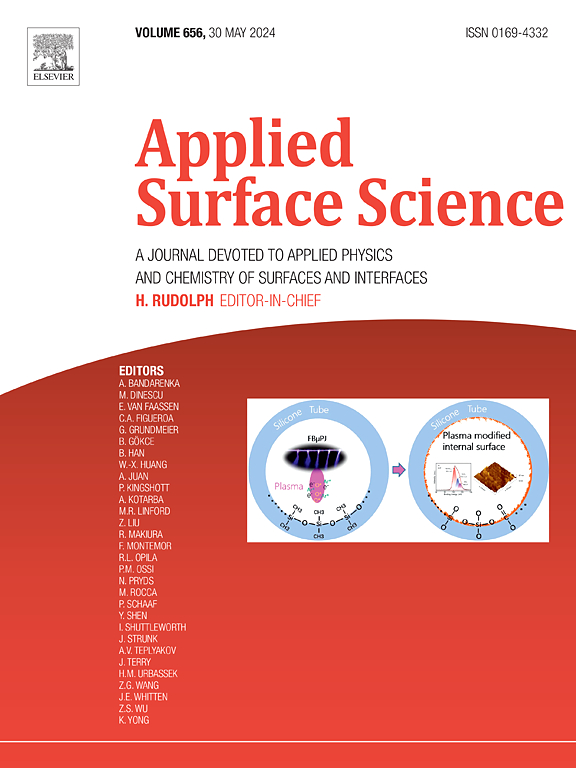含锡黏土矿物的消炎功能化研究
IF 6.3
2区 材料科学
Q2 CHEMISTRY, PHYSICAL
引用次数: 0
摘要
双氯芬酸是水生环境中检测到最多的药物之一,但它可以通过吸附去除。在本研究中,钠膨润土(Na-Bent)通过与 SnCl2 水溶液(0.01、0.05 和 0.10 mol L-1)反应,被一种 Sn 物种功能化,并被用作双氯芬酸的新型吸附剂。X 射线衍射图样和 Rietveld 精炼分析表明,样品中存在水合 SnO2 或 Sn(OH)4 纳米颗粒。Sn0.01-、Sn0.05- 和 Sn0.10-Bent 样品中的 SnO2 含量分别为 12.8%、32.4% 和 45.0%。样品的比表面积有所增加,Sn0.1-Bent 的比表面积达到 194 m2 g-1。X 射线光电子能谱(XPS)表明,Sn-Bent 中存在 Sn (IV) 物种。吸附等温线表明,Sn0.05-和 Sn0.10-Bent 样品的药物吸附量很高,分别达到 106.1 和 105.5 mg g-1。傅立叶变换红外光谱(FT-IR)和 XPS 分析表明,双氯芬酸钠的羧基与 Sn-Bent 样品中的 Sn 物质之间存在相互作用。盐蚯蚓测试表明,Sn0.10-Bent 无毒,而且所有样品在 pH 值为 6 的条件下吸附双氯芬酸时都表现出良好的稳定性。本文章由计算机程序翻译,如有差异,请以英文原文为准。


Functionalization of a clay mineral with Sn species for anti-inflammatory removal
Diclofenac is one of the most detected drugs in aquatic environments, however, it can be removed through adsorption. In the present study, sodium bentonite (Na-Bent) was functionalized with an Sn species by reaction between the clay and aqueous SnCl2 solutions (0.01, 0.05 and 0.10 mol L-1), and used as new adsorbents for diclofenac. X-ray diffraction patterns with Rietveld refinement analysis indicated the presence of hydrated SnO2 or Sn(OH)4 nanoparticles in the samples. SnO2 content in the samples were 12.8, 32.4, and 45.0 % for Sn0.01-, Sn0.05- and Sn0.10-Bent, respectively. The specific surface area of the samples increased, reaching 194 m2 g−1 for Sn0.1-Bent. X-ray photoelectron spectroscopy (XPS) suggested the presence of Sn(IV) species in Sn-Bent. The adsorption isotherms indicated high drug adsorption, reaching 106.1 and 105.5 mg g−1 for Sn0.05- and Sn0.10-Bent samples, respectively. Fourier transform infrared (FT-IR) spectroscopy and XPS analyses showed an interaction between the carboxylate group of diclofenac sodium and the Sn species in the Sn-Bent samples. Artemia salina tests indicated that Sn0.10-Bent was not toxic, and all samples showed good stability during diclofenac adsorption at pH 6. Therefore, Sn-Bent samples behaved as environmentally friendly adsorbents for the removal of diclofenac.
求助全文
通过发布文献求助,成功后即可免费获取论文全文。
去求助
来源期刊

Applied Surface Science
工程技术-材料科学:膜
CiteScore
12.50
自引率
7.50%
发文量
3393
审稿时长
67 days
期刊介绍:
Applied Surface Science covers topics contributing to a better understanding of surfaces, interfaces, nanostructures and their applications. The journal is concerned with scientific research on the atomic and molecular level of material properties determined with specific surface analytical techniques and/or computational methods, as well as the processing of such structures.
 求助内容:
求助内容: 应助结果提醒方式:
应助结果提醒方式:


